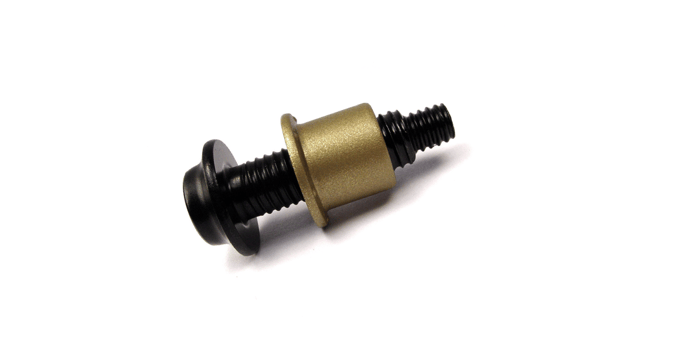
Traditional fasteners loosen under vibration. No matter how hard you tighten them, nuts and bolts will loosen with time if they are subjected to regular shaking. In order to solve the problem, engineers developed new types of vibration-resistant fasteners, so today you have a variety of fastener types from which to choose. There are many applications for which you need vibration-resistant fasteners. Factory equipment, for example, continually vibrates when in use. Vibration also has to be a consideration when building automobiles, railcars, ships, or virtually any mode of transportation. Over the years, engineers have tried different approaches, such as using washers to lengthen the ratio of the clamped length, thread lockers, and safety wires or lock wires. Ultimately, vibration-resistant fasteners have proven to be the most effective solution for long-term-use, tough applications. They also are easy to install and maintenance-free.
There are six popular types of vibration-resistant fasteners. Each type is installed in its own fashion and each is best for specific types of installations.
1. Lockbolts
Lockbolts have come into common use in manufacturing and construction. They are easy to install and do not loosen over time, no matter how much vibration they have to withstand. Unlike conventional nuts and bolts, lockbolts create a permanent joint.
The lockbolt consists of two pieces, a pin and a collar. When installing a lockbolt, the pin is positioned through a pre-drilled hole and the collar is fitted over the pin on the opposite side. Using a special lockbolt tool, the pin is pulled to bring the joint together and the collar is crushed or swaged around the pin to form a tight, permanent bond. The collar is locked onto the grooves of the pin, and this metal-to-metal friction prevents the lockbolt from loosening.
There are two basic types of lockbolts: those with pintails and those without. Lockbolts with pintails have a narrow section molded into the pin, where it can be sheared off by the installation tool once the collar is set. Otherwise, the pin is left intact, as withpintail lockbolts.
There are a variety of lockbolts on the market, but the two most popular lockbolt brands are Huck and Avdel.
Huck lockbolts are made by Huck/Howmet Aerospace and are used in a wide variety of applications. The Huck C6L® is the original Huck lockbolt available in sizes from 3/16-3/8 inches in steel, stainless steel, and aluminum. The Huck Bobtail® has a shallower thread than most lockbolts, so when the collar is swaged, there is more metal-to-metal contact to share the load, which increases fatigue strength. The Huck Magna-Grip® offers a wide grip range so the same lockbolt can be for various applications. The Huck C50L® is a large-diameter lockbolt with round, flush, and countersunk heads. The Hucktainer® is designed specifically for joining composite boards in trailers without crushing them. The Hucktainer features a wide head to prevent pull-through and seal the joint, and has a low profile so it won’t catch on clothes or goods. There are Huck lockbolts available for almost any job.
Avdel lockbolts also come in various shapes and sizes. The Avdelok®, for example, is a high-strength lockbolt with a controlled clamp that is ideal for heavy engineering applications, and the Avdelok XT is for especially heavy-duty joints. The NeoBolt® is a no-pin lock bolt designed for fast, consistent installation. The Maxlok® has a wide grip range with a high shear strength. And the Avtainer® is specifically designed for composite panels and applications in which you need a wide head to form a leak-proof joint and prevent pull-through.
2. The Huck 360
The Huck 360® falls into a category of its own. It looks like a conventional nut and bolt, but the nut itself is made of a softer material. When it is tightened, it creates its own metal-on-metal seal with the bolt, so it won’t loosen. This means the Huck 360 can be loosened and retightened using conventional tools and still won’t loosen under vibration. It is rated to deliver five times the fatigue life of a standard thread bolt and is available in diameters from 3/8 inches to one inch as well as metric sizes.
3. Blind Bolts
Blind bolts are extremely versatile and are used in a variety of applications, from manufacturing to bridge building, because they can be installed from one side and create a joint that is stronger than a weld or rivet. Blind bolts use a steel pin, a collar, and a sleeve to create a joint using a tool that works much like a riveter. The bolt is inserted into a pre-drilled hole, and when it is tightened, the collar is pressed into the facing side to create a seal while the sleeve is drawn in and collapsed on the blind side. Installation is fast and easy.
Two of the most popular blind bolts are the Huck BOM and the Avdel Avbolt.
The Huck blind oversized mechanical bolt (BOM) is made of steel and available in diameters from 3/16-3/4 inches. They are often used as a replacement for welding; one Huck BOM can do the work of four conventional fasteners.
The Avdel Avbolt is used in construction, mining, railway car manufacturing, and even bridge building. It uses an alloy steel pin and a carbon steel, zinc-plated collar and ranges in size from 3/16-5/8 inches. The Avbolt has a reputation for being extremely versatile and tough.
4. Structural Blind Rivets
Structural blind rivets are similar to blind bolts or rivets but have a groove in the sleeve that locks the mandrel once the pin is removed. These rivets, also called interlock rivets, are preferred for high-stress applications because of their increased shear strength, their increased pullout strength, and their resistance to vibration.
Huck/Howmet Aerospace makes structural blind rivets, such as the HuckLok®, which has a wide grip range and double-locking mechanism that secures the rivet on both sides of the material. The HuckLok has a large blind-side footprint to prevent pull-through and is ideal for joining together thin or soft materials such as plastics or composites.
The Huck Magna-Lok® can be installed using conventional fastener tools and has a unique circle lock feature that makes inspection easy. The Magna-Lok can be made of steel, stainless steel, or aluminum in diameters up to 1/2 inch.
The Huck Auto-Bulb® was developed for high-speed assembly lines. It has an easy-to-use lead-in point for fast installation and clamps to produce a broad, blind-side bulb, which is good for thin materials and oversized, misaligned, or slotted holes. The Auto-Bulb comes in steel and stainless steel.
The Huck Magna-Bulb® is designed to deliver high shear strength with a bulbing action that spreads the load over a wider surface area. This makes the Magna-Bulb ideal for thin materials and oversized holes in which pullout is a concern.
The Huck FloorTight® was developed as a controlled, self-countersinking fastener for large vehicle flooring installations. The FloorTight is ideal for connecting wood to metal, and because it is self-countersinking, it eliminates the need for additional counterboring.
5. Wellnut Threaded Inserts
Another common strategy to reduce vibration is to use wellnut threaded inserts. These are flanged inserts made of rubber or similar soft materials. The insert is passed through the hole in the workpiece and the bolt is passed through the insert. The nut is inserted from the flanged end and as the bolt that is passed through the insert is tightened and expands to make a tight, vibration-resistant seal around the bolt hole.
Wellnut inserts are manufactured by Bayfast, Marson, POP, and other vendors and come in different dimensions and lengths.
6. Coil Thread Inserts
Although originally designed to repair stripped bolt holes, coil thread inserts also are extremely strong, which makes them ideal vibration-resistant fasteners. Also known as helical wound inserts, coil thread inserts are coiled pieces of wire that are screwed into pre-drilled holes. They are commonly used in softer materials, such as wood, aluminum, or plastic, in which drilled screw threads easily strip and won’t hold a bolt. Once the insert is in place, the bolt can be screwed in place, causing the insert to expand against the walls of the bolt hole for an extremely strong, vibration-resistant joint.
There are two basic types of coil thread inserts: tanged and tangless. The tang is a piece at the end that extends across the diameter of the coil and is used by the insert tool to screw the coil in place. Once the coil insert is set, the tang is snapped off. Tangless inserts use a notch to drive the coil in place, eliminating the need to remove the tang. There are both free-running coil inserts and tanged screw-locking inserts that have a straightened coil segment in the center that is flexed outward when the bolt is inserted to lock the coil more securely in place.
The most popular threaded coil inserts are made by KATO Fastening Systems and Huck/Howmet Aerospace.
The Kato CoilThread inserts are made of cold-rolled steel with a tensile strength of more than 200,000 psi and are commonly used in the aerospace industry. They are made of various materials for different applications, including nickel-chromium alloy, phosphor bronze, chromium-cobalt alloy, and titanium.
The Huck/Howmet Aerospace Recoil® wire thread inserts are made of various materials in multiple sizes for use in auto repairs, ship building, making power generators, making consumer electronics, building cars and other forms of transportation, and other applications. In addition to coming in a wide range of materials, Recoil inserts come with various lubricants and coatings so they can resist extreme temperatures and corrosion and be used for special applications.
There are a wide range of vibration-resistant fasteners on the market, and it’s not always obvious which is the right fastener for the task. Bay Supply carries one of the largest inventories of vibration-resistant fasteners available, and our experts are always available to help you choose the right fastener for any application.




Comments